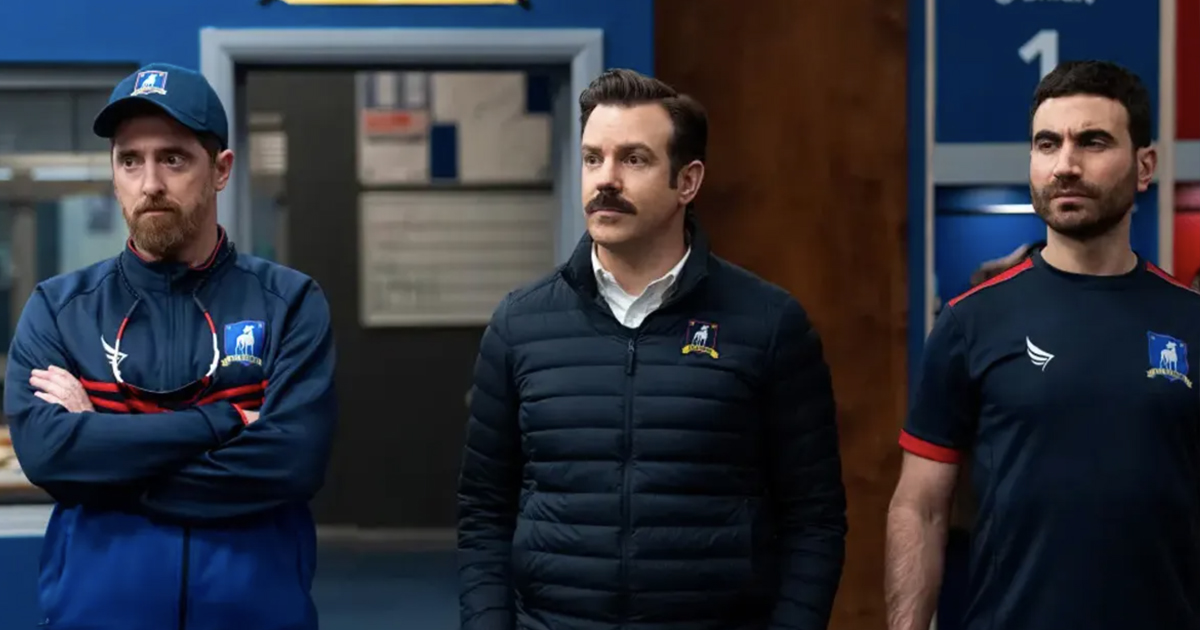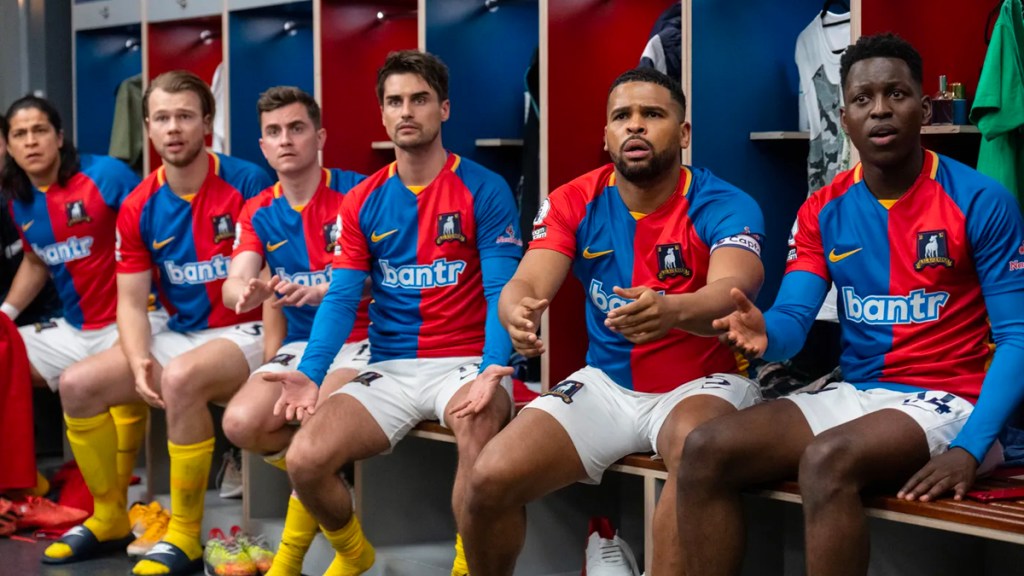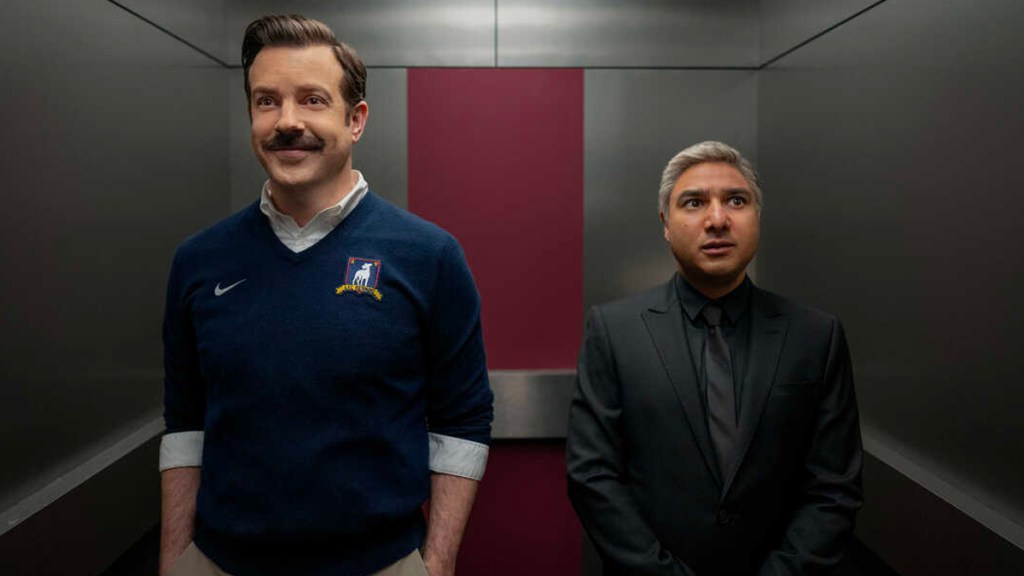
[This interview was originally posted on our sister website, AwardsRadar]
Apple TV+’s Ted Lasso was a sleeper hit for the streaming service. The brainchild of SNL alum Jason Sudeikis, along with Bill Lawrence, Brendan Hunt and Joe Kelly, the show follows Ted Lasso, an American college football coach who is hired to coach an English soccer team with the secret intention that his inexperience will lead it to failure, but whose folksy, optimistic leadership proves unexpectedly successful.
The series was based on a character that Sudeikis first portrayed in a series of promotional ads for NBC Sports’ coverage of England’s Premier League. It went on to earn 20 nominations at the 73rd Primetime Emmy Awards, becoming the most nominated freshman comedy in Emmy Award history. It won 7 awards, including Outstanding Comedy Series and acting awards for stars Sudeikis, Brett Goldstein and Hannah Waddingham.
Its sophomore season earned another 20 nominations, winning four awards, including Outstanding Comedy Series. Its third and final season has received 21 Emmy nods, including Outstanding Comedy Series and Outstanding Lead Actor in a Comedy Series for Sudeikis.
The series was also nominated for Outstanding Single-Camera Picture Editing for a Comedy Series. We spoke with editors A.J. Catoline and Melissa McCoy about maintaining the show’s tone, the craft of cut aways, and working with the VFX team.
Thank you for taking the time to speak with us, and congratulations is on the Emmy nominations. Well deserved.
Melissa McCoy: Thank you.
I’d like to talk first about the show’s tone. Can you talk about maintaining the show’s very specific comedic and dramatic tone within the editing process?
Melissa McCoy: Yeah, it’s something we always are aware of, and I think that was something we found naturally through the performances in season one, I think both AJ and I thought we were going to sign on for a silly comedy, and then as the performances were coming in, and the scripts were coming in, we were like, “Oh, you know, there’s a lot more depth here to these characters.” But yeah, it’s just the beauty of how the scripts are written, with so much heart. And then, like in life, there’s just a lot of comedy. You can find comedy in the darkest times of life. People that I’ve talked to you that have gone through tough times in life still like to laugh. Laughing is cathartic, even in the darkest times.
I know for myself, right before the show, I went through chemo for cancer, though it was a very curable kind of cancer. But, even in the darkest times, found times to laugh. So, then to go on and work on a show where, people reach out and say, “I have the ‘Believe’ sign up in my my my room when I’m going through chemo or going through a divorce, and the show meant so much to me.” We do a few tricks where we can take breath and create a transition. I know AJ has an example of one, so I’ll let him jump in.
A.J. Catoline: Yeah, the show will sometimes take these these hard right terms from either comedy to sad, or sad to comedy. I think that’s what Jason is going for. He’d ask me how an episode was going a lot, and I’d say, “Well, it’s really moving and emotional, but there’s some good jokes and relieving moments, and he’d say, “Good, that’s what we’re going for.” He wants to make the audience laugh and cry. But I think what Mel is talking about is in Episode Seven, we had this scene where Sam goes to see his restaurant and it’s been vandalized and trashed. He looks up on the wall, and it says, “Shut up and dribble on the wall,” and the camera just pulls back. It’s just very sad shot, but then the next scene in the script was the team joking around the locker room, I just knew those two were going to be a hard to put together. So, I took a little breath and cut to that James Lance, Trent Crimm, jotting in his notebook and thinking about what were the four points that Ted was trying to convey to the team. It was just a good transition piece, because he’s Trent Crimm, so he’s very serious, but he’s also makes a funny face, so then that took us into the locker room. So yeah, that’s just a specific example of finding just a breath.
But that’s been the challenge on the whole show going back to Season One, where we thought we’re gonna come on and do something like a sketch comedy show, which is where Ted Lasso started as, and then I’m reading the scripts about Ted getting divorce as like, “Wow, this doesn’t read comedy,” and it didn’t always play like one. But, I think the comedy at its best when it can also make you cry makes me cry. They are two similar emotions when you’re editing, and I think Jason’s been very smart to mix those. But editorially, we have followed his lead and his vision. Yeah, he’s a Saturday Night Live comedian, but he’s not always going for humor. He was always going for something a bit more nuanced, and I think we did that in the in the cutting room.

Melissa McCoy: It’s always focused on the characters, so it just feels so human. No humans are laughing and joking all the time. So, I think that’s been our saving grace is that we basically follow the characters and whatever they’re feeling we’re feeling. I think that’s why people love the character so much is because we show them as multifaceted. They’re not always going for the joke.
A.J. Catoline: They’re people. They’re showing vulnerability. We were thrilled that Phil Dunster, who plays Jamie Tartt, finally got an Emmy nomination. He’s always been an arrogant prick, idiot guy, but in his stupidity, there’s great emotion. When he reveals to Roy that he’d lost his wings, you have this very heartfelt deep emotion, but it’s hysterical.
There is a lot of character development over the course of the three seasons, especially with the secondary characters. How much of that falls on your shoulders?
A.J. Catoline: So you mean specifically with the secondary characters?
Yeah, I think as an audience, we’re expecting character arcs with the leads like Ted and Rebecca, but many of the secondary characters had arcs that I don’t think we were necessarily expecting.
A.J. Catoline: Jason said that many times to me, because my instinct was always to try to find a great cutaway to Ted , but he would say, “The show’s called “Ted Lasso.” It’s not always about Ted lasso.” It’s a very much an ensemble piece, especially this season. It really feels like the team is a character from episode one of Season Three, where they’re all in the sewer together, all the way to Episode 12, where they’re doing “So Long, Farewell.” The team as a unit is a is a character.

How do you find a balance with reaction shots? How do you determine how long to hold on a shot before you cut away versus staying with it? Is it script dependent? Is it performance dependent?
Melissa McCoy: I think a lot of it is performance and the story we’re trying to tell. I’m thinking of the scene in the finale when Nate apologizes to Ted and he’s crying. They turn to look up and the Believe sign is not there, and Ted says, “You know it’s crazy, I still think it’s there,” And Nate says, “I think so too.” It felt like such an important scene for the two of them. They’d been apart for so long, and they had this big journey together. So much of Nate’s story happened off screen. We would come in kind of after the fact, and I think Jason found that to be the most interesting place to be. It’s the meat of what happens after that that’s really interesting to him. So, that was an important scene to stay with them.
Then Ted leaves and Nate looks up, and I stay on him, and it was a lot of massaging- maybe giving it more time and maybe giving it a longer dissolve. That was the end of the first act of that of that episode and we’re going to transfer into the big game montage. I just kept adding more frames, it was just like, “It just needed to be longer.” A lot of times, the note we get is, “Can you make this faster? Can you make this happen quicker?” And sometimes that’s not best for the story. So, it was a very long shot up on the wall. I think it was something like almost a 200 frame dissolve. So it was a case by case basis, and I think it’s always driven by character.
I feel the streaming services allow you that flexibility. Every episode of “Ted Lasso” has had been as long as it needed to be, and I feel that you probably have a lot of say in that.
A.J. Catoline: Yeah, us and Jason. To their credit, Apple would send notes back like, “We were not bothered by the length of the show.” They wanted to tell the story. And yes, you do have that freedom with with streaming, as opposed to if you’re cutting to a specific clock, I go back and watch Season One and I’m really amazed by how ‘pacey’ it is. That’s credit to Bill Lawrence, who is a genius in a cutting room. He would have us pace these things up a lot, and then we’d pull them back a little bit, because Jason felt they were too pace. But it was very snappy, and I think we needed that to get the audience’s to know the show. Then in Season Two, we started pushing over 40 minutes, and then Season Three, we were just like, “Let’s just have a party here,” and the episodes are over an hour and you know, It didn’t become so much about time but it for us editorially, we began the season like, “Whoa, now these are 12 individual feature films.”
But it was always about telling story and taking our time. Jason was the absolute creator and showrunner for season three, and he just had that vision. He had that story to tell. People ask me what’s left on the cutting room floor, and it’s not much at all. We’ll cut lines out, we’ll start a scene little later or a little sooner, but it’s there as written. It was just about getting into the nuance and having the right pace. But we had lot of a lot of freedom this year to take a half an hour comedy and make it over an hour.
Can you talk about the challenges of editing a football match, especially one that’s got a narrative?
Melissa McCoy: Yeah, the finale had a 20-minute football game, and it’s got its technical challenges because that’s all visual effects. We film those on a practice field, and our wonderful VFX house, Barnstorm adds the whole stadium, the crowds, the advertisements. So there’s that whole technical beast. We have to know where they are on the field, and as the VFX start coming in, it’s like, “Oh, the the game clocks back there.” So, then beyond story we’re tracking the time of the match and the score, and anything else that might be on the board.
One of the things that I was also looking at when the VFX were coming in was, “Okay, this is a big moment. Is this advertisement too distracting?” So there were all these technical things you have to do in addition to telling the story. At first, you’re just telling the story. You’re not worrying about the stadium or any of that yet really. You focus on the story and who needs to feel which moment. You have Rupert up in the stands, you have Rebecca, you have Ted on the sidelines, and then you have the dynamics that are playing on the field.

We had so many callbacks of things that we had set up in previous episodes. In episode 103, they run Nate’s play with Trent Crimm watching. That’s the day he comes to spend the day with a team. And they run this play, and Ted comes out and says, “No, no, no, I want you to sell it. Jamie’s gonna run decoy and he goes, ‘Me, me, me pass me the ball. I will like the ball please,” which was one of my favorite things of season one that I cut. So now Jamie is going to do that, and I wanted Jamie to be as close as to Jason’s performance as possible. So I had the original take up while I was editing, and since Phil gave five or six different versions, I had to decide which one was closet to Jason’s.
Because the games were so big, I was doing this where everybody had a color code in my Avid. So, Rebecca was a color, Ted was a color, the team was a color. We also have Dr. Sharon watching and Michelle in watching. So, I can kind of see how far apart each person was in the edit, and see who needed to feel what during this game. And because this whole world is so big, now there are a lot of places you could go. But, you also you have to tell the action on the field. So, it was about trying to elongate time as long as you could to fit in all these reaction shots. It really was a puzzle this season.
Then you have to go through, once the VFX come in, and say, “Oh my gosh, I think the stadium needs to be turned this way,” and, “Oh my gosh, we picked a shot that’s a difficult move for a visual effects house to do in the in a shorter amount of time.” It’s lot of finessing the VFX so the story can shine. So, it’s it’s a big undertaking. I don’t think people realize that it’s a big visual effects show with big action sequences in the middle of this heart. I feel very lucky that I got to do that. At this point, bring on anything, because we can we can do it.
A.J. Catoline: And this season was the first season that the Premier League came in and licensed us the use of their stadiums. So we got to go to Man City, and Westham, and Chelsea. That was great. Mel and I would get the action right up front. We had a great football director who would shoot all that, and once we knew we had that storytelling going on the field and once we figured out when we’d have to be up in the classic soccer angle from up high versus on the field level, once we got that right, seeing the visual effects come in toward the end would make a make it really come to life.
“Ted Lasso” is currently streaming on Apple TV+.

